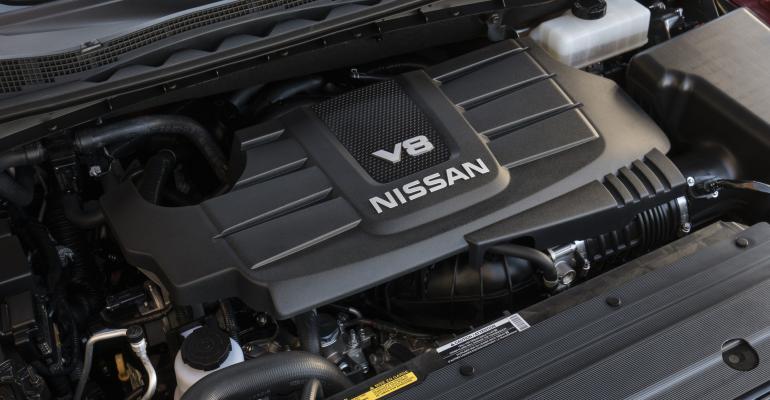MILFORD, MI – Go big or go home, poker players say, and Nissan appears to have taken that phrase to heart with its redesigned Endurance V-8 in the ’17 Titan large pickup.
The Decherd, TN-built 5.6L DOHC gasoline V-8 boasts 390 hp at 5,800 rpm and 394 lb.-ft. (534 Nm) of torque at 4,000 rpm, making it one of the most powerful volume pickup engines on the market. Nissan plans to soon add a V-6 to the Titan. That engine will cater to entry-level customers and a large portion of its commercial business.
The 5.7L Hemi V-8 in the Ram 1500 owns the power crown at 395 hp and 410 (556 Nm) of torque. General Motors offers a 6.2L V-8 in its Chevy Silverado and GMC Sierra with 420 hp and 460 lb.-ft. (623 Nm) of torque, but it is a premium execution of the small-block.
Greg Schoenborn, manager-Titan marketability at Nissan North America Technical Center, says the engineering goal was a big power number to draw attention to the second-generation pickup, which drew lackluster demand the first time around against longtime industry fixtures from Ford, GM and Ram.
But the Japanese automaker also is taking what amounts to a single-engine strategy in the segment, whereas a competitor such as the Ford F-150 offers an industry-leading four-engine options. To satisfy a wider range of demands, Nissan figured it needed an engine with punch.
“We are trying to hit that sweet spot to cover all customers,” Schoenborn tells WardsAuto on the sidelines of a Titan media preview here.
Ironically, the rural farming community is just a stone’s throw from the GM proving grounds and where Silverados and Sierras stack three- and four-deep at stoplights.
“So it has enough capability to tow at max towing, but still meet our fuel economy,” Schoenborn adds. “It’s a balance, but certainly when you go from the old Titan to the new one, it is a completely different experience.”
The 5.6L V-8 in the previous generation Titan made 317 hp and 385 lb.-ft. (522 Nm) of torque, with peak fuel economy of 13/18 mpg (18-13 L/100 km) city/hwy in 2-wheel-drive models. The new one delivers 15/21 city/hwy (15.7-11.2 L/100 km).
The addition of gasoline direct injection provides much of the power and fuel-economy gains, Schoenborn says, by reducing knock, improving combustion stability and offering more precise injection control. It also raises the compression ratio to 11.2:1 from 9.8:1.
But Nissan also added variable valve event and lift and multi-control valve technologies.
VVEL combines hydraulic-controlled variable valve timing with electronically controlled variable valve lift on the intake and exhaust sides to boost performance and throttle response times, the automaker says. Throttle response is enhanced by directly controlling the intake valve instead of using a throttle valve, Nissan says. MCV is designed to help manage thermal efficiency better than a traditional thermostat.
“It is a much more advanced powertrain, although it shares the same displacement,” Schoenborn says. “Our targets were best-level acceleration, along with best-level fuel economy.”
A 7-speed automatic transmission from gearbox expert Jatco also is new to the Endurance V-8, replacing a 5-speed unit.
“It’s a very good transmission, with smooth, fast shifts,” Schoenborn says. “That’s one of the big reasons we’re able to achieve the fuel economy we did.”
The new engine and transmission also appear in the redesigned Nissan Armada and as an alternative to the 5.0L Cummins V-8 in the Titan XD.





